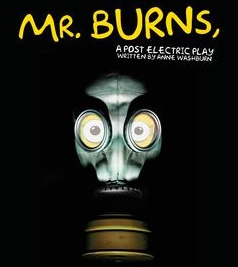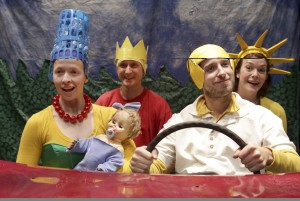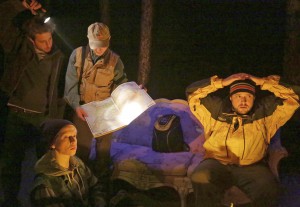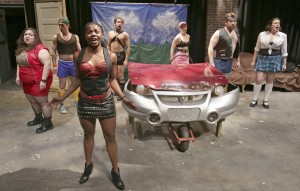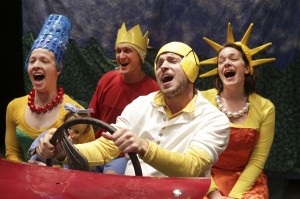LET THERE BE DARK
In endurance sagas such as Lord of the Flies and The Blue Lagoon, stranded youngsters on deserted islands try to reimagine civilization by mimicking adult classics, or else surrender to the anarchy that underlies’”and undermines’”innocence.
A similar phenomenon happens in Anne Washburn’s post-apocalyptic fantasy Mr. Burns, a Midwest premiere from Theater Wit. Scattered survivors of a once-electrified society gather around campfires and sustain themselves by relating’”and eventually reenacting’”cultural echoes from happier days. Mostly the group’s goal is to retrieve animated scenes from The Simpsons cartoon series. They piece together a new existence from the fragments of an old comedy as they search for lost loved ones. The result is a distorted post-pop culture mirror of an irretrievable past. Better, it seems, to remember television than to curse the darkness.
Just how the lit world ended is unknown, but radiation poisoning remains a danger, as well as the vague threat of hostile outsiders. The one constant over the course of three acts that span 80 years is the moral support provided by memories of zanies Bart, Lisa, Marge and Homer, as well as the sadistic Itchy & Scratchy, villainous Sideshow Bob and, especially, the venomous nuclear mogul Mr. Burns (he becomes the symbol of the dead past’s corruption and failure).
The focus in each act is on dramatizing one or more convoluted Simpsons episodes. Inevitably, the recreation becomes more and more desperately elaborate, a cult-like ceremony of consolation. Seven years after the opening fireside scene, the reenactors are performing in an abandoned theater, adding made-up commercials that culminate in a huge group dance performed to sitcom theme songs (choreography by Brigitte Ditmars, musical direction by Andra Velis Simon). At one point things get slightly interesting when a cast member argues for some meaning’”more realism and sharper motivation–in their reenactment. But she’s quickly told to shut up. As Buckingham Palace said of the royal family, “You don’t shine daylight on magic.”
Lacking anything like social media, this compulsive retelling, amplified by half-remembered fragments from Gilbert and Sullivan, becomes a raison d’etre for the dwellers in dystopian darkness. The craze creates lethal competition for performance rights and audiences for these crude simulations of the Fox series (one rehearsal ends in an ear-splitting volley of gunfire).
As with the Telephone Game, the now lost episode mutates as it gets retold. By play’s end a fogbound tableau vivant depicts Mr. Burns attacking the family on the houseboat where they sought escape (the Cape Fear films, which were parodied as “Cape Feare” in a Simpsons episode, have also been blended into the story). This flamboyant simulation, presented on set designer Joe Schermoly’s flatbed cobbled from spare parts, is now a spectacle of Mara Blumenfeld’s caricaturing and elaborately improvised costumes, and Mike Durst’s descending electroliers, glowing illuminations, and assorted son et lumière. The alternately fearsome and clichéd musical pageant depicts an uncowed Bart defeating the no-longer electrifying Mr. Burns (alas, the only juice produced comes from a bicycle-pumped generator).
That’s the premise and payoff of Washburn’s pseudo-naïve concoction. Necessarily, much here depends on how much you already like or recognize The Simpsons. On opening night audience members were in stitches as the eight wayfarers crudely recreated an imperfectly remembered early episode. Yes, there’s winsome amusement in the second act where the Simpson-makers clumsily attempt to put on their endangered show. The third act offers scary fun as the first act’s storytelling morphs into a communal ritual of slaughter and renewal; What, you wonder, would we hold onto if the lights went off forever?
But throughout this increasingly manic “post-electric” odyssey we’re only given effects, not causes. We can only guess what horrors have happened by witnessing the organized denial behind this obsession with a TV series. Why this one was chosen is among many issues never addressed. It could just as easily be a Seinfeldian knockoff “about nothing.”
Ultimately, Mr. Burns is strangely sad. It’s not all that urgent either. It’s actually a somewhat sick joke that’s played on us more than for us. But, no question, Jeremy Wechsler’s knockout production is a glorious extravaganza of dumpster-driven make-believe. The eight actors create their own force field to fuel this energy-deprived aftermath of Commonwealth Edison. For many camp followers, their pizzazz, as much as pop-culture in-jokes and premature nostalgia for the citizens of Springfield, may be entertainment enough.
The cast: Kelley Abell, Daniel Desmaris, Hannah Gomez, Christina Hall, Andrew Jessop, Leslie Ann Sheppard, Jeff Trainor, and Leah Urzendowski
photos by Charles Osgood
Mr. Burns, a Post-Electric Play
Theater Wit, 1229 W. Belmont Ave.
scheduled to end on March 1, 2015
EXTENDED to April 11, 2015
for tickets, call 773.975.8150 or visit www.TheaterWit.org
for more info on Chicago Theater, visit www.TheatreinChicago.com
